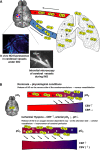Nitric oxide: considerations for the treatment of ischemic stroke
- PMID: 22333622
- PMCID: PMC3390820
- DOI: 10.1038/jcbfm.2012.12
Nitric oxide: considerations for the treatment of ischemic stroke
Abstract
Some 40 years ago it was recognized by Furchgott and colleagues that the endothelium releases a vasodilator, endothelium-derived relaxing factor (EDRF). Later on, several groups identified EDRF to be a gas, nitric oxide (NO). Since then, NO was identified as one of the most versatile and unique molecules in animal and human biology. Nitric oxide mediates a plethora of physiological functions, for example, maintenance of vascular tone and inflammation. Apart from these physiological functions, NO is also involved in the pathophysiology of various disorders, specifically those in which regulation of blood flow and inflammation has a key role. The aim of the current review is to summarize the role of NO in cerebral ischemia, the most common cause of stroke.
Figures


Similar articles
-
NO: the primary EDRF.J Mol Cell Cardiol. 1999 Jan;31(1):5-14. doi: 10.1006/jmcc.1998.0839. J Mol Cell Cardiol. 1999. PMID: 10072711 Review.
-
Role of endothelium-formed nitric oxide on vascular responses.Gen Pharmacol. 1990;21(5):575-87. doi: 10.1016/0306-3623(90)91002-9. Gen Pharmacol. 1990. PMID: 2276579 Review.
-
Intact and altered endothelium in regulation of vasomotion.Circulation. 1992 Dec;86(6 Suppl):III12-19. Circulation. 1992. PMID: 1424046 Review.
-
Endothelium-derived relaxing and contracting factors.J Cell Biochem. 1991 May;46(1):27-36. doi: 10.1002/jcb.240460106. J Cell Biochem. 1991. PMID: 1874796 Review.
-
Nitric oxide--the endothelium-derived relaxing factor and its role in endothelial functions.Gen Physiol Biophys. 2010 Dec;29(4):319-40. Gen Physiol Biophys. 2010. PMID: 21156995 Review.
Cited by
-
A quantitative spatiotemporal analysis of microglia morphology during ischemic stroke and reperfusion.J Neuroinflammation. 2013 Jan 11;10:4. doi: 10.1186/1742-2094-10-4. J Neuroinflammation. 2013. PMID: 23311642 Free PMC article.
-
Targeting nitric oxide in the subacute restorative treatment of ischemic stroke.Expert Opin Investig Drugs. 2013 Jul;22(7):843-51. doi: 10.1517/13543784.2013.793672. Epub 2013 Apr 18. Expert Opin Investig Drugs. 2013. PMID: 23597052 Free PMC article. Review.
-
Guanosine prevents nitroxidative stress and recovers mitochondrial membrane potential disruption in hippocampal slices subjected to oxygen/glucose deprivation.Purinergic Signal. 2016 Dec;12(4):707-718. doi: 10.1007/s11302-016-9534-3. Epub 2016 Sep 9. Purinergic Signal. 2016. PMID: 27613537 Free PMC article.
-
Theta Frequency Electromagnetic Stimulation Enhances Functional Recovery After Stroke.Transl Stroke Res. 2025 Apr;16(2):194-206. doi: 10.1007/s12975-023-01202-z. Epub 2023 Nov 14. Transl Stroke Res. 2025. PMID: 37962771 Free PMC article. Clinical Trial.
-
Inhibition of autophagy and glycolysis by nitric oxide during hypoxia-reoxygenation impairs cellular bioenergetics and promotes cell death in primary neurons.Free Radic Biol Med. 2013 Dec;65:1215-1228. doi: 10.1016/j.freeradbiomed.2013.09.006. Epub 2013 Sep 19. Free Radic Biol Med. 2013. PMID: 24056030 Free PMC article.
References
-
- Adams HP, Jr, del Zoppo G, Alberts MJ, Bhatt DL, Brass L, Furlan A, Grubb RL, Higashida RT, Jauch EC, Kidwell C, Lyden PD, Morgenstern LB, Qureshi AI, Rosenwasser RH, Scott PA, Wijdicks EF. Guidelines for the early management of adults with ischemic stroke: a guideline from the American Heart Association/American Stroke Association Stroke Council, Clinical Cardiology Council, Cardiovascular Radiology and Intervention Council, and the Atherosclerotic Peripheral Vascular Disease and Quality of Care Outcomes in Research Interdisciplinary Working Groups: the American Academy of Neurology affirms the value of this guideline as an educational tool for neurologists. Stroke. 2007;38:1655–1711. - PubMed
-
- Alp NJ, Channon KM. Regulation of endothelial nitric oxide synthase by tetrahydrobiopterin in vascular disease. Arterioscler Thromb Vasc Biol. 2004;24:413–420. - PubMed
-
- Amarenco P, Bogousslavsky J, Callahan A, III, Goldstein LB, Hennerici M, Rudolph AE, Sillesen H, Simunovic L, Szarek M, Welch KM, Zivin JA. High-dose atorvastatin after stroke or transient ischemic attack. N Engl J Med. 2006;355:549–559. - PubMed
-
- Amarenco P, Labreuche J, Lavallee P, Touboul PJ. Statins in stroke prevention and carotid atherosclerosis: systematic review and up-to-date meta-analysis. Stroke. 2004;35:2902–2909. - PubMed
-
- Amin-Hanjani S, Stagliano NE, Yamada M, Huang PL, Liao JK, Moskowitz MA. Mevastatin, an HMG-CoA reductase inhibitor, reduces stroke damage and upregulates endothelial nitric oxide synthase in mice. Stroke. 2001;32:980–986. - PubMed
Publication types
MeSH terms
Substances
LinkOut - more resources
Full Text Sources
Medical
Miscellaneous

